Strategic Review of Innovation in the Payments System: Results of the Reserve Bank of Australia's 2010 Consumer Payments Use Study – June 2011 3. The Current Payments Landscape
The use of various payment methods, as reported in the 2010 diary, is summarised in Table 1.[5] Cash accounted for 62 per cent of all payments made by individuals, but less than one-quarter of the value of all payments. By contrast, payments by personal cheque, BPAY and internet/telephone banking collectively accounted for less than 10 per cent of the number of payments, but around one-quarter of the value of payments. Card-based payments made up the bulk of the remainder, accounting for around one-third of the total number and value of payments.
| Payment method | Share of number | Share of value(a) | |
|---|---|---|---|
| Cash | 62 | 23 | (29) |
| eftpos | 13 | 12 | (15) |
| MasterCard/Visa debit card | 8 | 10 | (12) |
| MasterCard/Visa credit card | 8 | 12 | (14) |
| BPAY | 3 | 10 | (10) |
| Internet/telephone banking | 2 | 10 | (12) |
| American Express/Diners Club card | 1 | 1 | (1) |
| Paymate, PayPal & POLi | 1 | 1 | (1) |
| Other(b) | 1 | 16 | (3) |
| Personal cheque | 1 | 5 | (3) |
|
(a) Figures in brackets exclude transactions of $9,999 or above Source: Roy Morgan Research |
|||
As with the 2007 Study, the diary results suggest that consumers make a higher share of total card payments with debit cards than indicated by other sources, and a correspondingly lower share of card payments with credit cards.[6] This appears to be mainly driven by some study respondents over-estimating their use of scheme debit cards (MasterCard/Visa debit cards), possibly because of confusion between scheme debit and credit cards, which look quite similar.[7] Business payments are also excluded from the Consumer Payments Use Study; business payments are more likely to be made with credit cards than debit cards.
Payment Size
The 2010 diary results suggest that most payments made by individuals are for low values. Transactions up to $50 account for around three-quarters of the number of payments, but only one-fifth of the value of payments (Graph 1). By contrast, only 0.1 per cent of transactions are more than $5,000, but they account for over 20 per cent of the value of payments. These payments fall into the holiday travel, services and ‘other’ merchant categories.
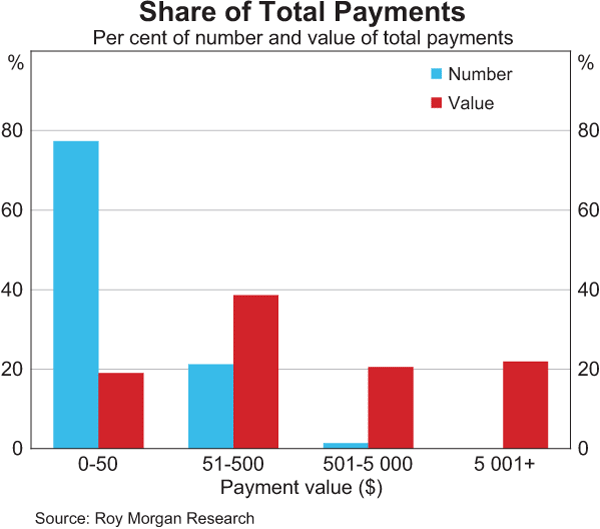
Payment size is an important factor in determining which payment method is used (Graph 2). Cash is the dominant payment method for low-value transactions, making up around 80 per cent of payments of $25 or less and almost three-quarters of payments of $50 or less, but accounts for only a small share of high-value transactions. Cards are the dominant payment method for mid-sized transactions, with the share of card payments made on credit cards increasing as the payment value increases. BPAY, internet/telephone banking and personal cheques (not shown separately in Graph 2) are important for high-value payments.
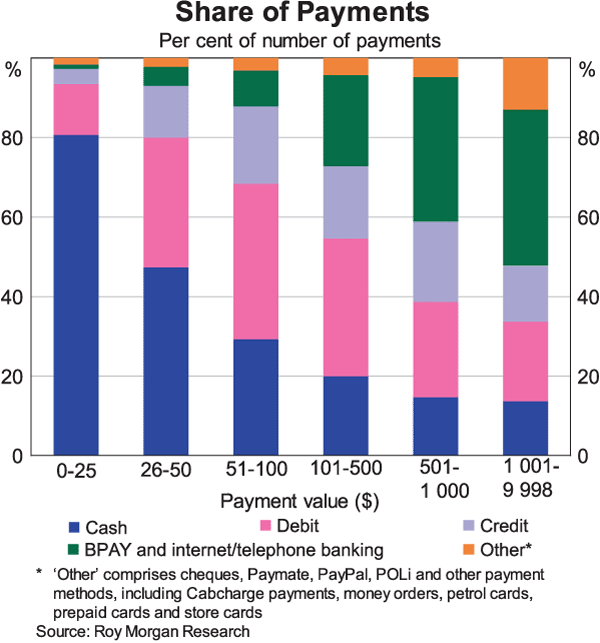
Median payment values are consistent with the above payment patterns (Table 2). Cash payments have the lowest median value (at around $12), reflecting the dominant role of cash for low-value transactions, while methods used to pay bills, such as BPAY and internet/telephone banking, have the highest medians (around $100 and $132, respectively). These median values are largely unchanged from the 2007 Study.
| Payment method | Dollars |
|---|---|
| Internet/telephone banking | 132 |
| BPAY | 100 |
| Personal cheque | 90 |
| American Express/Diners Club card | 50 |
| MasterCard/Visa credit card | 49 |
| eftpos | 38 |
| MasterCard/Visa debit card | 38 |
| Paymate, PayPal & POLi | 27 |
| Other(a) | 16 |
| Cash | 12 |
|
(a) ‘Other’ payment methods include Cabcharge payments, money orders, petrol cards, prepaid cards and store cards Source: Roy Morgan Research |
|
Merchant Category
Payment patterns across merchant categories are broadly consistent with the 2007 Study.[8] Cash is the dominant method where average payment values are low and where quick tender times are preferred, such as at take-away stores, pubs and small food stores (Table 3). Cheques are used infrequently and tend to be used when the average payment value is high, such as for holiday travel, household bills and services. BPAY stands out as a key method for paying household bills, although its share of these transactions is over-stated because direct debits – which are not captured in the diary – also account for a high proportion of bill payments.[9] Cards are used across a wide range of merchants, with debit card use particularly strong in the petrol, electrical/furniture, holiday travel, supermarket and health merchant categories, while credit cards are used most heavily for holiday travel payments.
The 2010 Study also captures, for the first time, payments made by internet/telephone banking, and specialised online payment schemes, such as PayPal. Combined, these methods are significant for household bills (21 per cent) and ‘other’ payments (13 per cent).
| Cash | Debit card | Credit/ charge card |
BPAY | Personal cheque | Internet/telephone banking and online schemes(b) |
Other(c) | |
|---|---|---|---|---|---|---|---|
| Take-away | 87 | 10 | 3 | * | * | * | * |
| Pub/bar | 86 | 11 | 3 | * | * | * | * |
| Small food store | 85 | 11 | 4 | * | * | * | * |
| Restaurant | 85 | 11 | 4 | * | * | * | * |
| Leisure | 75 | 12 | 6 | 1 | 1 | 5 | * |
| Transport | 73 | 10 | 8 | 1 | * | 1 | 7 |
| Other | 62 | 13 | 5 | 3 | 3 | 13 | 1 |
| Other retailer | 58 | 27 | 13 | 1 | * | 1 | * |
| Services | 56 | 22 | 11 | 2 | 4 | 5 | * |
| Supermarket | 54 | 34 | 12 | * | * | * | * |
| Health | 44 | 32 | 19 | 1 | 2 | 1 | 1 |
| Petrol | 43 | 41 | 14 | * | * | * | 2 |
| Electrical/furniture | 31 | 40 | 17 | 1 | * | 8 | 3 |
| Holiday travel | 21 | 38 | 31 | 3 | 3 | 4 | * |
| Household bills | 15 | 16 | 6 | 38 | 3 | 21 | 1 |
|
(a) Amounts less than 0.5 per cent are marked with an asterisk Source: Roy Morgan Research |
|||||||
Payment Channel
The majority of both the number and value of consumer payments are made in person (Table 4). Internet and phone payments are the next most popular payment channels, together accounting for around one-tenth of the number of all payments and one-third of the value of payments. By contrast, payments by mail account for a negligible share of both the number and value of payments.
| Number | Value | |
|---|---|---|
| In person | 91 | 67 |
| Internet | 7 | 26 |
| Phone | 2 | 6 |
| * | 1 | |
|
(a) Amounts less than 0.5 per cent are marked with an asterisk Source: Roy Morgan Research |
||
Remote payments – all payments not made in person – are used mainly for household bills and holiday travel (Graph 3). Within remote payments, internet payments are widely used across all categories, whereas payments by mail tend to be used for particular categories – notably for holiday travel, ‘other’ and services. Phone payments are used in most categories where remote payments are made, but are particularly strong in the categories of household bills and holiday travel.
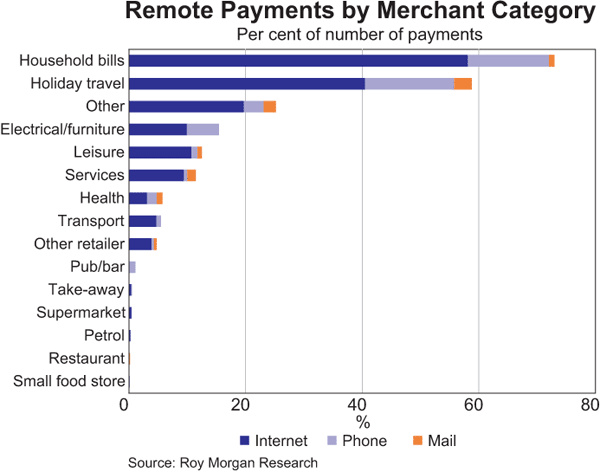
The end-of-study questionnaire asked consumers about the factors that determine their choice of payment method when paying at the point of sale. Consumers were asked to mark all relevant factors and then to indicate which of these factors was the most important. A considerable proportion of consumers indicated that they simply use what they happen to be carrying with them. In terms of the characteristics of different payment methods, the speed of the transaction, a preference to use their own funds (that is, their deposit rather than credit account), and the ease of managing finances, were considered the most important factors in choosing which payment method to use (Graph 4). The importance of speed possibly explains why cash continues to be used for low-value transactions; however, it also suggests that there is the potential for cash displacement as transaction times for card payments decline. While reward points and charges were identified by around 30 per cent of consumers as factors affecting their payment decisions, relatively few identified either as the most important factor.
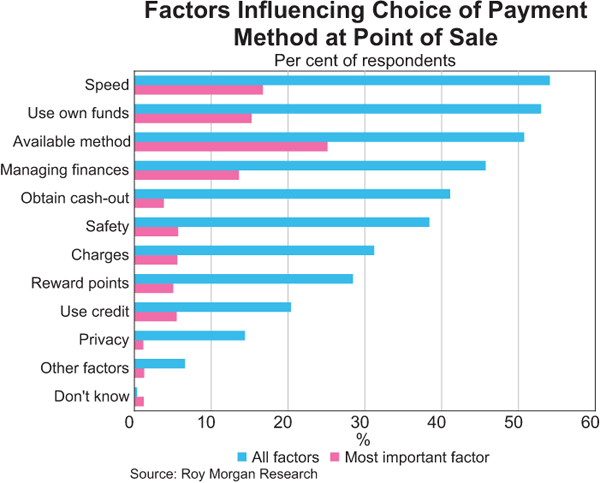
These preferences are reflected in the actual choices of payment methods made by respondents during the diary study (Graph 5). For example, consumers who highly valued being able to use their own funds made a higher share of their in-person payments with a debit card. Conversely, those respondents who indicated that the most important factor determining their choice of payment method was either reward points or their preference to use credit made a higher share of their payments with a credit card. Cash use was most dominant for respondents who valued privacy and speed of processing. Also, respondents who valued the ability to obtain cash at the point of sale also tended to use cash relatively more than other respondents (and their use of eftpos was also relatively higher).
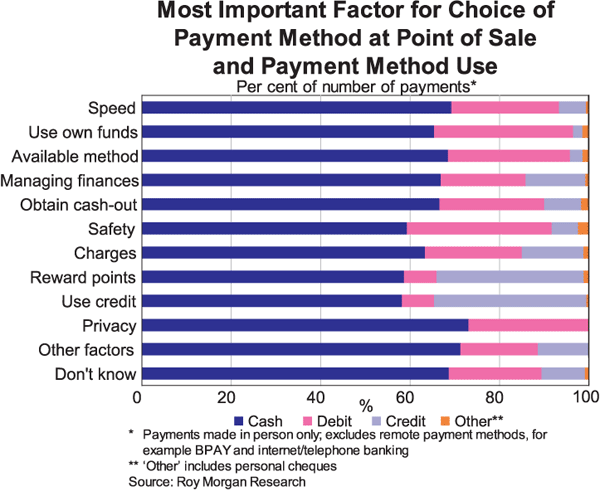
The Evolution of Payment Patterns and Cash Withdrawal Behaviour
The use of payment methods has evolved to some degree over the past three years.[10] Most noticeably, the relative use of cards has grown strongly while the use of cash has declined (Table 5). Although the average use of cash actually increased slightly between the two studies, the increase was less than for other payment methods (Table 6). Therefore, the share of cash use in the total number of payments decreased from 70 per cent in 2007 to 64 per cent in 2010. The average number of card payments made by each respondent in a week increased from around 3.5 payments to 4.8 payments over the same period, while the average value of these card payments increased from $290 to $390. Within debit cards, growth has been particularly strong for payments on MasterCard/Visa debit cards. As discussed earlier, study respondents may have had difficulty distinguishing between credit and debit card transactions. Nevertheless, strong growth in the use of scheme debit cards is consistent with other data sources, possibly reflecting the active promotion of scheme debit cards in the period following the first study.
| Number | Value | ||||
|---|---|---|---|---|---|
| 2007 | 2010 | 2007 | 2010 | ||
| Cash | 70 | 64 | 39 | 34 | |
| Card | 27 | 32 | 45 | 51 | |
| Personal cheque | 1 | 1 | 6 | 3 | |
| BPAY | 2 | 3 | 10 | 12 | |
|
(a) Figures are based on payment methods included in both the 2007 and 2010 studies Source: Roy Morgan Research |
|||||
| 2007 | 2010 | |
|---|---|---|
| Cash | 9.3 | 9.5 |
| eftpos | 1.5 | 2.1 |
| MasterCard/Visa credit card | 1.4 | 1.2 |
| MasterCard/Visa debit card | 0.5 | 1.3 |
| American Express/Diners Club card | 0.1 | 0.2 |
| Total | 12.8 | 14.3 |
|
(a) The average number of payments may be affected by survey fatigue, whereby fewer payments are recorded towards the end of the diary period, although the effect is likely to be small Source: Roy Morgan Research |
||
The study data also suggest that there have been changes in the use of personal cheques and BPAY, with payments by personal cheque declining and payments by BPAY increasing. These trends are consistent with payment patterns observed in the Reserve Bank's regular data collection (which includes payments by business) and are a continuation of longer-term trends, as shown in Graph 6 for the non-cash payment methods.
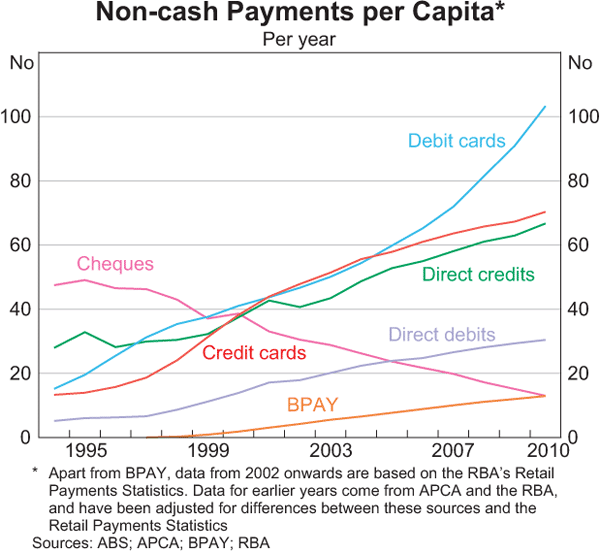
Similar patterns can be seen in the proportion of respondents using each payment method at least once in the first week of the diary period (Table 7). These data give an indication of how widely different payment methods are used. Again, by this measure the data suggest an increase in the use of eftpos and scheme debit cards and a decline in the use of credit cards. The decline in the use of personal cheques is much more pronounced, indicating that cheque use is becoming rarer for most people. BPAY use has become much more widespread over recent years, with around one-quarter of respondents using BPAY at least once a week. Almost all consumers used cash, reinforcing the fact that, although cash use is declining, it remains an essential payment method.
| 2007 | 2010 | |
|---|---|---|
| Cash | 95 | 97 |
| eftpos | 44 | 49 |
| Credit card(a) | 36 | 29 |
| MasterCard/Visa debit card | 18 | 35 |
| BPAY | 13 | 24 |
| Personal cheque | 12 | 7 |
|
(a) Credit card includes transactions on MasterCard/Visa credit cards and American Express/Diners Club credit/charge cards Source: Roy Morgan Research |
||
Consumers' cash withdrawal behaviour has changed significantly over the past three years. The average number of cash withdrawals made by an individual in a week (from the three main withdrawal methods) decreased by 6 per cent between 2007 and 2010 (Graph 7). Over the same period, the average value of cash withdrawn in a week increased from $270 to $322 (Graph 8).
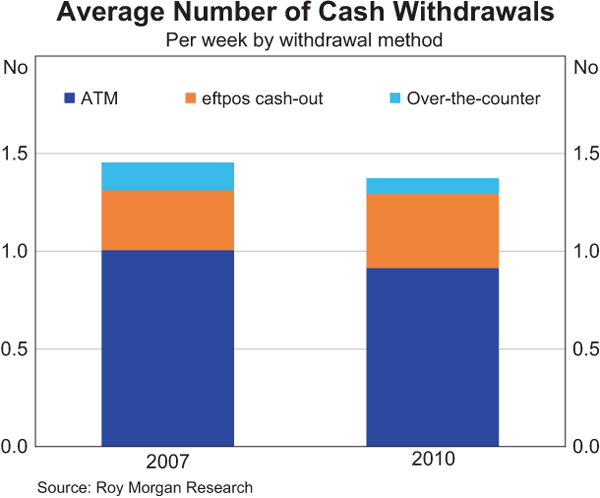
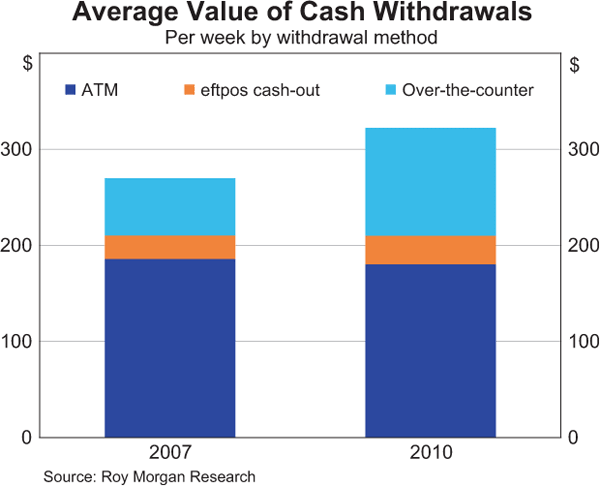
One of the main factors that may have influenced this change in cash withdrawal behaviour was the move to direct charging at ATMs from early 2009. This reform increased the transparency and flexibility of ATM charges, leading consumers to change their behaviour to avoid these charges. The impact of this reform is analysed in more detail in Section 6.
Footnotes
Graph 1 and Table 1 include transactions for all payment values. Subsequent tables and graphs include only transactions less than $9,999 to ensure that the 2007 and 2010 data are comparable. Although the 2007 diary allowed high-value payments to be recorded, the format of the diary and the diary instructions may have discouraged respondents from entering payment amounts of greater than four digits. One large transaction amount was also truncated to $9,999 by Roy Morgan Research. [5]
The 2010 diary results indicate that debit cards account for 71 per cent of the number of total card payments. By contrast, the Reserve Bank's regular data collection – the Retail Payments Statistics – suggests that the debit card share of card payments is around 62 per cent – almost 10 percentage points lower than the diary results. Differences can also be found when comparing the eftpos share of payments, with the 2010 diary results indicating that eftpos accounts for 44 per cent of the number of card payments, while the Retail Payments Statistics suggest a share closer to 52 per cent. However, the diary results and the Retail Payments Statistics are not strictly comparable, as the diary is limited to personal transactions, whereas the Retail Payments Statistics cover both personal and commercial transactions for debit cards (for credit cards, personal and commercial transactions are separately identifiable). [6]
While MasterCard and Visa debit cards are required to be visually identifiable, this may not have eliminated confusion for all respondents, particularly as a scheme debit card transaction requires the consumer to press ‘credit’ at the point of sale. In the payments diary, the option for scheme debit was intentionally positioned above scheme credit to emphasise the existence of the debit alternative. But this may also have biased respondents towards selecting debit when in doubt as to the true nature of the transaction. [7]
See Appendix B for a description of the merchant categories used in the 2010 Study. [8]
The use of direct debits is analysed in more detail in Section 4. [9]
For comparisons between the 2007 and 2010 studies, we exclude payment methods not included in both studies, as well as payment methods classified in the ‘other’ category, unless otherwise stated. This is aimed at achieving a like-for-like comparison, whereby we are comparing the same payment methods in both 2007 and 2010; the ‘other’ category is excluded because of uncertainty over the types of transactions recorded in that category. In addition, Roy Morgan Research made some corrections to demographic data for some of the 2007 study participants, resulting in revisions to the 2007 weights. As a result, the 2007 results reported in this paper may differ slightly from those originally reported by Emery et al (2008). [10]